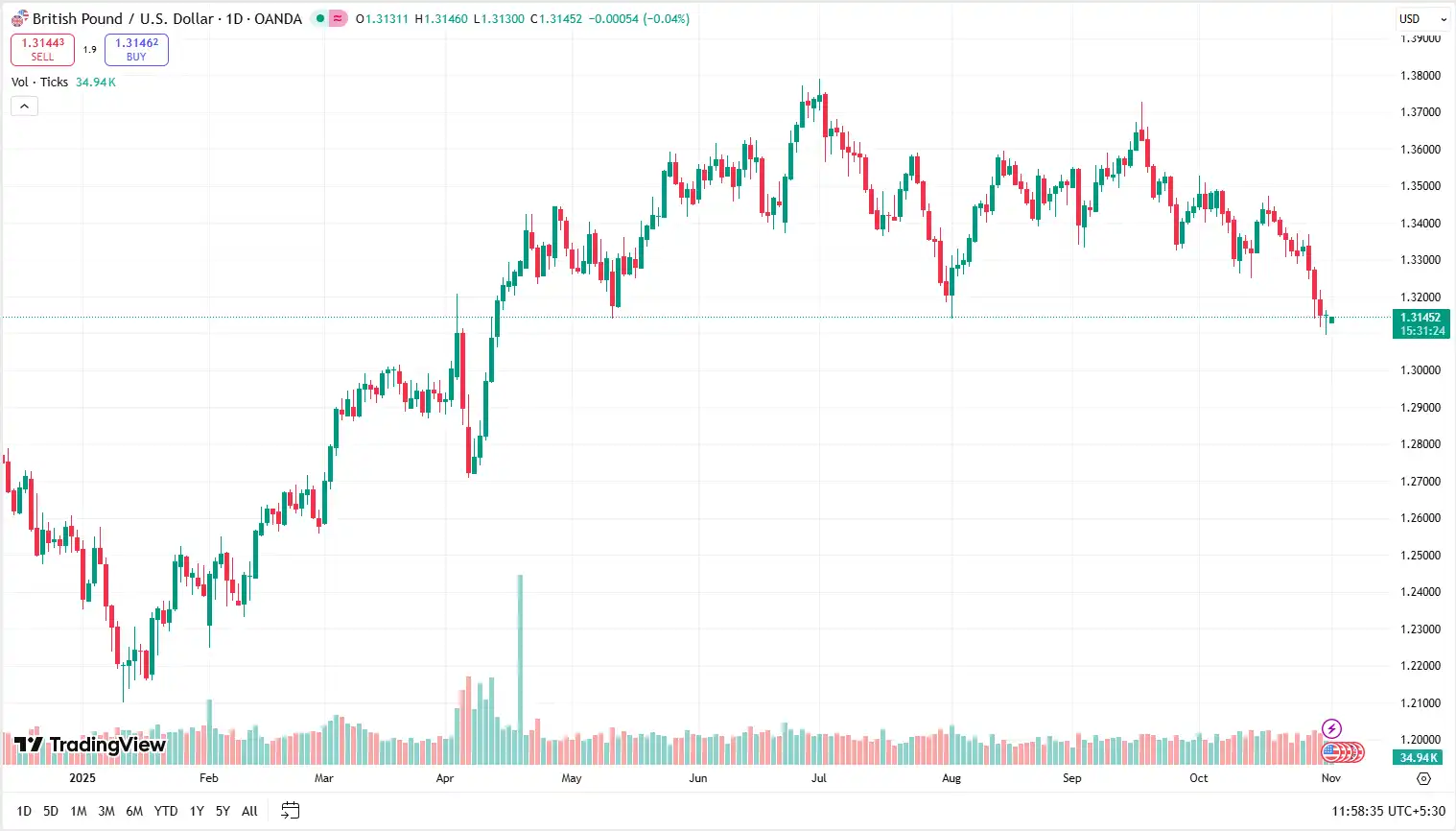EUR/USD extended its decline for the fourth consecutive session and traded around 1.1530[1] in Monday's Asian session. It is believed that the pair is under pressure as the US dollar[2] appreciates due to the decreased expectations of the Fed to cut the rates in December. Market reports indicate that the move by the central bank last week to reduce again in 2019 the benchmark rate to the 3.75%-4.00% range initially weakened the greenback, although remarks by the Fed Chair Jerome Powell[3] dimmed additional dovish betting. Powell stressed that the next rate change in December is not a given, which indicates a cautious attitude when there is a paucity of economic data because of the current government shutdown.
Market analysts[4] note that the CME FedWatch Tool is currently showing a 69% likelihood of a cut in the Fed funds rate in December, a drastically different figure of 93% a week ago. This repricing has been a short-term rescue to the USD, as it has held EUR/USD on the defensive. Nevertheless, the economic outlook is still obscured by fears about the long-term presence of the US government shutdown[5] that is already in the sixth week. Lack of prompt macroeconomic release may increase uncertainty about how the US growth is faring so that the Dollar cannot move positively in the short run.
Market commentators[6] indicate that there was a lack of direction in the commentaries by European Central Bank (ECB) policymakers on the Eurozone side. The necessity of full optionality was repeated by ECB’s Francois Villeroy de Galhau[7], who implied that the policy should be flexible in the context of the ongoing financial and inflation threats. Meanwhile, Latvia’s Martins Kazaks[8] asserted that inflation and growth risks are being balanced with each other with the likelihood that the ECB will be likely to be kept on hold in the next few months.
Technically, analysts[9] suggest that EUR/USD is still bound below 1.1550, and that it is currently receiving support around 1.1500. The traders will pay close attention to the future US unemployment claim, and ISM services data later in the week, which will provide new signals on the Fed’s policy course[10], and shape the short-term movement of the two.

GBP/USD Extends Losses Amid Dollar Strengths
The GBP/USD pair started the week on a subdued note, extending its decline to trade around 1.3100[11] and hovering near its lowest level since mid-April. The bearish momentum of the pair is believed to be strong where sellers continued taking control after the hawkish comments made by Fed Chair Jerome Powell[12] last week. This cautious position of the Fed chief regarding the possible additional rate reductions in December has strengthened the position of the US dollar[13] that is trading near a three-month high amid strong Treasury yields and a general demand for safe-haven assets.
Market reports[14] point out that the pound is still performing poorly in the UK as fiscal anxieties are mounting ahead of the Autumn Budget by Finance Minister Rachel Reeves on November 26. Anticipations of more government borrowing, and less hard domestic data, have been weakening investor moods of sterling[15]. Traders are already trading in the event of a Bank of England (BoE) rate cut[16] with markets giving it a one-in-three probability of a 25-basis-point cut as early as next week's policy meeting and an even greater probability at the end of the year. The continuing downward action under the 200-day Simple Moving Average[17] gives the pessimistic picture a technical force.
Analysts[18] have pointed out that the upcoming focus will be on the key US macro releases such as the ISM Services PMI and weekly jobless claims soon that might affect expectations concerning the next course of action of the Fed. Any economic weakness will have the short-term ability to limit the dollar progress, but the bigger picture trend is in favour of the greenback.
Market commentators[19] project that GBP/USD short-term recoveries may not be discounted, but the medium-term trend of the pair is downward. The ongoing negative UK fiscal winds and an increasing policy difference between the Fed and BoE[20] indicates the likelihood of further negative downside to the 1.3000 handle in the next few sessions. Overall, the broader view indicates that the GBP/USD exchange rate could stay under persistent pressure due to varying monetary policies and ongoing UK fiscal volatility.

NZD/USD Holds Steady Amid Mixed Market Sentiment
The NZD/USD pair traded near 0.5715[21] in Monday’s Asian session, as investors weighed weak Chinese manufacturing data against improving US–China trade sentiment. It is believed that the New Zealand dollar[22] was held in a light tension after the publication of pessimistic Chinese economic data[23], which reduced the attraction to the risky properties. Due to the existing close trade relations with China, any indication of sluggish Chinese factory activity[24] is likely to have a disproportionate effect on the immediate performance of the kiwi.
Market reports point out that the China RatingDog Manufacturing Purchasing Managers Index (PMI)[25] dropped to 50.6 in October compared to 51.2 in the previous month, which is lower than the expectation of 50.9. The statistics strengthened fears that the post-pandemic momentum in the largest economy in Asia is waning, pulling the demand of major New Zealand exports[26]. This leaves the upside potential of the New Zealand dollar limited although the price action was relatively stable at the beginning of the week. The market participants will also be watching whether sentiment is going to be better after the US October ISM Manufacturing PMI[27] report later on Monday which may act as an additional indicator of the direction of the US dollar.
Market commentators[28] note that the US dollar met with some reprieve as the Fed dropped the second rate cut of the year marking the benchmark rate at 3.754%. Market expectations of further easing have, however, been tamed by the cautious tone of Fed Chair Jerome Powell[29], who indicated no guarantee of a further cut in December, now priced at around 63% as compared to 93% last week. This hawkish movement has kept the US dollar supporting, restricting the NZ/USD profits.
Analysts point out that in the future, traders will be keen on future US manufacturing and employment data[30] to provide more clues on the Fed policy direction. Although there is a trade hope between the US and China that can provide a short-term boost to the kiwi[31], there are underlying growth issues around the globe and a stronger US dollar indicates that NZD/USD might find itself subjected to further depreciation in the medium term.

USD/CAD Steadies as Oil Strength Limits Upside
The USD/CAD pair traded around 1.4010[32] in Monday’s Asian session, pausing after two consecutive days of gains. The pair is believed to be widely propped by a stronger US dollar[33] but are under pressure with the Canadian currency gaining due to increased crude prices. The market reports indicate that Canada has a close trade relationship with the energy markets and thus the loonie is still a sensitive currency to the movement of Oil and the West Texas Intermediate (WTI)[34] crude at the moment is holding strong at around $61.00 per barrel. The development of oil prices was driven by the decision of OPEC+[35] to indicate that there will be no further growth in output in the first quarter of 2026, which supports the near-term demand prospects of commodity-specific currencies.
Market observers[36] note that the US dollar has been gaining momentum at the end of last week, as the Fed reduced its benchmark interest rate to 3.75%-4.00% in its second interest cut this year, with indications that the Fed further easing open market operations may be in doubt next month. Fed Chair Jerome Powell[37] stressed a data-dependent strategy, stating that it would be necessary to exercise a high degree of caution when there are low levels of official data releases owing to the current US government shutdown. Markets reduced their anticipations of another reduction in the rate this year and the CME FedWatch Tool[38] indicated a likelihood of 69% that was 93% the previous week.
Market commentators[39] note that the wider risk-off mood and the current fears about US fiscal gridlock may serve USD/CAD well in the short term, as investors are going to be less attracted to risk assets. Nevertheless, the increase in Oil prices[40] and the stable growth in energy demand may restrain the upward movement of the pair as the Canadian dollar will experience the rise of commodity power.
Analysts[41] suggest that traders will keep a keen eye on future US macroeconomic indicators such as ISM services PMI and weekly jobless claims to provide new indications on growth momentum. The weaker information would rekindle anticipations of additional Fed ease, which would potentially put pressure on the US dollar and put the medium-term USD/CAD[42] dimension in censure.

Stay Ahead in the Currency Game
Whether you're a daily FX trader or handle international transactions regularly, our 'Currency Pulse' newsletter delivers the news you need to make more informed decisions. Receive concise updates and in-depth insights directly in your LinkedIn feed.
Subscribe to 'Currency Pulse' now and never miss a beat in the currency markets!
Ready to act on today’s insights? Get a free quote or give us a call on: +44 (0)20 7740 0000 to connect with a dedicated portfolio manager for tailored support.
Important Disclaimer: This blog is for informational purposes only and should not be considered financial advice. Currency Solutions does not take into account the investment objectives, financial situation, or specific needs of any individual readers. We do not endorse or recommend any specific financial strategies, products, or services mentioned in this content. All information is provided “as is” without any representations or warranties, express or implied, regarding its accuracy, completeness, or timeliness.




